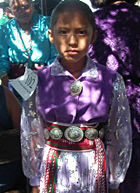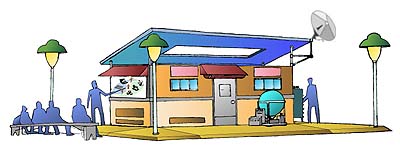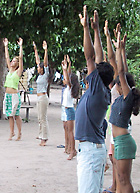 and digital culture Greenstar delivers solar power, health, education and environmental programs to small villages in the developing world -- and connects people in those villages, and their traditional culture, to the global community. We work with people in traditional cultures to express the voice of the community to the world through original music, artwork, photography and video and other arts. That voice is connected with respect and dignity to the land, to families, to language, tradition, to the past and to a clear vision of the future. Income from this priceless "digital culture" is used to fund an ongoing, community-driven process of literacy, local business, education and training, public health, and environmental programs.  To deliver these services efficiently and quickly, Greenstar has designed a portable community center. Using solar power generated by large photovoltaic panels, the center can drive a water purifier, a small clinic, a vaccine cooler, a classroom, a digital studio and a satellite or wireless link to the Internet. We work with the people of each village to develop an ecommerce website, employing local musicians, teachers and art professionals to record the voice of the community. Greenstar packages the materials for various markets, both direct to the consumer, and through licensing to businesses.
To date, we have completed pilot installations in a remote Bedouin settlement on the West Bank in the Middle East; in a small community in the Blue Mountains of Jamaica; in the central India village of Parvatapur; and in a traditional Ashanti community in Ghana. Centers have been started in New Mexico, Brazil and Tibet as well with a South Africa program in planning. In over 60 other communities on all continents of the world, Greenstar has developed connections with people who are interested in building an "Edge Network" of people, skills, ideas, tools and cultural voices that will be of incalculable value to the whole world -- and to the women, men, children and families of those villages.  Greenstar is a profit-making business. Our first priority is to profit our partners in developing countries, then investors (who come from all over the world), and then to profit Greenstar itself, in order to fund ultimate expansion to 300 centers worldwide. Our "future building" process helps bring people up the literacy curve in practical, measurable ways, based on their inherent cultural assets and not on mining of the resources of their land, or on exploitation of their cheap labor. Digital products available direct to the Internet consumer from the Greenstar World Gallery include music, paintings and drawings, photographs, video, poetry and stories, and new art forms such as animated panoramas. These products are also licensed by businesses, as "digital premiums" to communicate with customers and motivate their participation in a wide range of "green" programs, including alternative energy, textiles and clothing, and interactive entertainment.
 Greenstar works closely with local village leadership in a "future building" process. Above, leaders from India, Jamaica and the West Bank. Click here for a free selection of downloadable traditional music from villages around the world. Greenstar was founded in 1998 by a small group of people, including a high tech executive, the former head of the US Department of Energy's National Renewable Energy Lab, and a member of the White House Office of Media Affairs. Today, we embrace a stellar group of twenty Ambassadors as well, with world-class skills in finance, telecommunications, public relations, media production, international development, Internet technology and marketing, medicine and education. The company maintains a small, de-centralized network of offices in Los Angeles, Seattle, Cairo and Hyderabad, India.  5042 Wilshire Blvd., Ste. 575 Los Angeles, CA 90036 USA email editor@greenstar.org If you're still hungry for information after this introduction, chances are what you're looking for can be found in our FAQ (Frequently-Asked Questions). And if you want to get involved with Greenstar, there are three simple ways: subscribe to the free Greenstar Newsletter; join the Greenstar Explorers, our volunteer-intern program; or, if you're an organization, consider getting involved as a Greenstar Premium Partner.  photos by Kirsten Hintner in easily printable form.
|
The Tour: Click these links to see highlights of Greenstar's websites: The Sites:
Digital Culture:
In the high Tibetan plateau in 2003, a young boy welcomes a new Greenstar solar power center. Greenstar Community Center: The Newsletter: In the news:
Special Projects:
Leaders from the Brazilian community group Progreso Saude Alegria work with Greenstar to establish solar-powered community centers in the Amazonian villages of Suruaca and Urucurea. The Business: Why Greenstar?
Who? Getting Connected 
|


